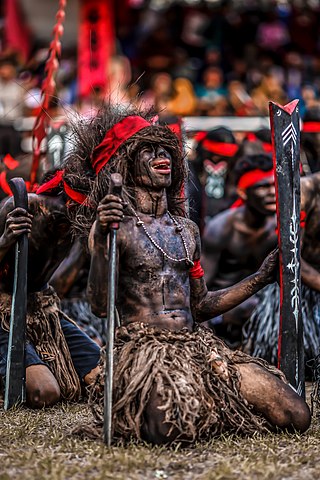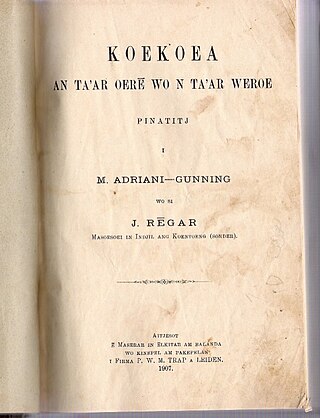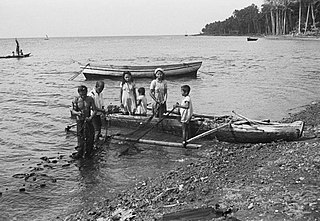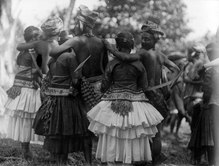
Sulawesi, also known as Celebes, is an island in Indonesia. One of the four Greater Sunda Islands, and the world's eleventh-largest island, it is situated east of Borneo, west of the Maluku Islands, and south of Mindanao and the Sulu Archipelago. Within Indonesia, only Sumatra, Borneo, and Papua are larger in territory, and only Java and Sumatra have larger populations.

Central Sulawesi is a province of Indonesia located at the centre of the island of Sulawesi. The administrative capital and largest city is located in Palu. The 2010 census recorded a population of 2,635,009 for the province, and the 2020 Census recorded 2,985,734, of whom 1,534,706 were male and 1,451,028 were female. The official estimate as at mid 2022 was 3,066,143. Central Sulawesi has an area of 61,605.72 km2 (23,786 sq mi), the largest area among all provinces on Sulawesi Island, and has the second-largest population on Sulawesi Island after the province of South Sulawesi. It is bordered by the provinces of Gorontalo to the north, West Sulawesi, South Sulawesi and South East Sulawesi to the south, by Maluku to the east, and by the Makassar Strait to the west. The province is inhabited by many ethnic groups, such as the Kaili, Tolitoli, etc. The official language of the province is Indonesian, which is used for official purposes and inter-ethnic communication, while there are several indigenous language spoken by the Indigenous peoples of Central Sulawesi. Islam is the dominant religion in the province, followed by Christianity which is mostly adhered to by the people in the eastern part of the province.

The Minahasans are an ethnic group native to the North Sulawesi province of Indonesia, formerly known as North Celebes. The Minahasa people sometimes refer to themselves as Manado people. Although the Minahasan pre-Christian creation myth entails some form of ethnic unification, before the nineteenth century the Minahasa region was in no way unified. Instead, a number of politically independent groups (walak) existed together, often in a permanent state of conflict.

The culture of Indonesia has been shaped by long interaction between original indigenous customs and multiple foreign influences. Indonesia is centrally-located along ancient trading routes between the Far East, South Asia and the Middle East, resulting in many cultural practices being strongly influenced by a multitude of religions, including Buddhism, Christianity, Confucianism, Hinduism, and Islam, all strong in the major trading cities. The result is a complex cultural mixture, often different from the original indigenous cultures.

Kaharingan is an indigenous animistic folk religion of the Katingan, Lawangan, Ma'anyan, Ngaju, and Ot Danum people native to the Central Kalimantan region in Indonesia.

The Torajans are an ethnic group indigenous to a mountainous region of South Sulawesi, Indonesia. Their population is approximately 1,100,000, of whom 450,000 live in the regency of Tana Toraja. Most of the population is Christian, and others are Muslim or have local animist beliefs known as aluk. The Indonesian government has recognised this animistic belief as Aluk To Dolo.

Batak is a collective term used to identify a number of closely related Austronesian ethnic groups predominantly found in North Sumatra, Indonesia, who speak Batak languages. The term is used to include the Karo, Pakpak, Simalungun, Toba, Angkola, and Mandailing which are related groups with distinct languages and traditional customs (adat).
The Central Sulawesi Christian Church is the largest Christian church in Central Sulawesi, Indonesia. It belongs to the Reformed family of churches. The church was established in the early 1893 through the mission work of the Dutch Reformed Church and became an independent denomination in 1947 when Indonesia declared its independence from the Netherlands and ordered all Dutch nationals to go home. November 1993, there was in Tentena a celebration feast for 100 years Christianity.

Cakalele dance is a war dance from North and Central Maluku in Indonesia. Hybrid versions also exist among the natives of Sulawesi, Timor, and the Tanimbar Islands. The dance is performed by men, two of whom represent opposing captains or leaders while the others are the warriors supporting them. After an opening ritual, the captains engage in a mock-duel with a spear (sanokat) and long knife (lopu) while their supporters use a long knife in the right hand and a narrow wooden shield in the left hand. The shield is referred to as a salawaku, or by a local name such as the Tobelo o dadatoko. The cakalele originated as a way for the warriors to celebrate after a successful raid. Dancers dress in full warrior costume and are backed by the rhythm of the drum and gong (tifa) and fife (sulin).

Several different religions are practised in Indonesia. Indonesia is officially a presidential republic and a unitary state. Indonesia has the world's largest Muslim population and the first principle of Indonesia's philosophical foundation, Pancasila, requires its citizens to state "the One and almighty God". Consequently, atheists in Indonesia experience official discrimination in the context of registration of births and marriages and the issuance of identity cards. In addition, the Aceh province officially enforces Sharia law and is notorious for its discriminatory practices towards religious and sexual minorities. There are also pro-Sharia and fundamentalist movements in several parts of the country with overwhelming Muslim majorities.

Christianity is Indonesia's second-largest religion, after Islam. Indonesia also has the second-largest Christian population in Southeast Asia after the Philippines, the largest Protestant population in Southeast Asia, and the fourth-largest Christian population in Asia after the Philippines, China and India. Indonesia's 28.6 million Christians constituted 11% of the country's population in 2018, with 8% Protestant (20.3 million) and 3% Catholic (8.3 million). Some provinces in Indonesia are majority Christian. In recent times, the rate of growth and spread of Christianity has increased, especially among the Chinese minority.

Malaysian folk religion refers to the animistic and polytheistic beliefs and practices that are still held by many in the Islamic-majority country of Malaysia. Malaysian folk faith is practiced either openly or covertly depending on the type of rituals performed.
Kaili is an Austronesian dialect cluster of the Celebic branch, and is one of the principal languages of Central Sulawesi. The heartland of the Kaili area is the broad Palu River valley which stretches southward from Central Sulawesi's capital city, Palu. Kaili is also spoken in the mountains which rise on both sides of this valley, and along the coasts of the Makassar Strait and the Gulf of Tomini.

Poso Regency is a regency of Central Sulawesi Province of Indonesia. It covers an area of 7,112.25 km2, and had a population of 209,228 at the 2010 Census and 244,875 at the 2020 Census; the official estimate as at mid 2021 was 248,345. The principal town lies at Poso.

Tontemboan is an Austronesian language, of northern Sulawesi, Indonesia. It is a Minahasan language, a sub-group of the Philippine languages.
Mun or Munism is the traditional polytheistic, animist, shamanistic and syncretic religion of the Lepcha people. It predates the 7th century Lepcha conversion to Lamaistic Buddhism, and since that time, the Lepcha have practiced it together with Buddhism. Since the arrival of Christian missionaries in the nineteenth century, Mun traditions have been followed alongside that religion as well. The traditional religion permits incorporation of Buddha and Jesus Christ as deities, depending on household beliefs.

Sangirese or Sangihe people are one of the native people to the Sangir Islands in the northern chain of islands in Sulawesi and the southern part of Mindanao. The Sangirese people are fishermen and nutmeg growers in their home areas and also work as wage labourers in industrial crops enterprises in Bolaang Mongondow Regency and Minahasa Regency.

Nicolaus Adriani was a Christian missionary from the Netherlands who did work in Indonesia. He studied linguistics of the East Indies at Leiden University, obtaining his PhD in 1893. He was sent by the Nederlandsch Bijbelgenootschap. He worked as a linguist in Poso, Central Sulawesi.
Ngkai Talasa or Talasa Tua, was the eighth King who ruled Poso in 1919 until 1948. He was known for his openness to immigrants who want to stay in Poso, as long as they respect each other and respect local wisdom in Poso.

Albert Christian Kruyt was a Dutch Calvinist missionary, ethnographer and theologian. He was the first to pioneer Christianity in Central Sulawesi, notably in Poso.
















